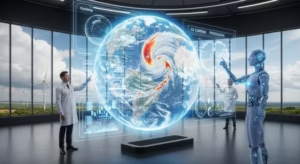AI and Climate Change: Smart Solutions for a Greener Future

The blog post titled AI and Climate Change: Smart Solutions for a Greener Future explores the transformative role of AI in addressing climate change. It discusses how AI enhances climate modeling and projections, allowing for more accurate forecasting and assessment of environmental impacts. The article highlights innovative technologies for carbon tracking using AI, which enable companies and governments to monitor and reduce emissions effectively. Moreover, it delves into the role of AI in climate change mitigation by optimizing energy consumption and promoting sustainable practices. Finally, the post outlines actionable steps to implement AI solutions for environmental impact, providing a roadmap for businesses and policymakers seeking to leverage AI for a greener future. Overall, the integration of AI and climate change initiatives holds significant promise for achieving sustainable goals and combating climate challenges.
How AI Enhances Climate Modeling And Projections

Artificial Intelligence (AI) is revolutionizing various fields, and one of its most vital applications is in climate modeling. By leveraging advanced algorithms and large datasets, AI enhances the accuracy and efficiency of climate projections. This innovative approach allows researchers to analyze complex climate data more effectively, identifying patterns and relationships that traditional methods might overlook. As the urgency to address climate change intensifies, employing environmental AI becomes essential for creating robust models that can predict future climate scenarios with greater precision and reliability.
One significant advantage of AI in climate modeling is its ability to process vast amounts of data from various sources. This is complemented by AI techniques that include machine learning, neural networks, and natural language processing, which facilitate better forecasting. These techniques allow scientists to run simulations that predict the impact of climate change on different ecosystems and human settlements. In particular, the integration of AI enables a more refined understanding of local climate effects, thereby aiding policymakers and stakeholders in making informed decisions about mitigation strategies.
AI Techniques and Their Applications in Climate Modeling
| Technique | Application | Benefits |
|---|---|---|
| Machine Learning | Predictive analytics for climate change | Improves accuracy of predictions |
| Deep Learning | Analyzing satellite imagery | Enhanced observation of environmental changes |
| Natural Language Processing | Processing climate-related texts | Extracts insights from vast literature |
| Simulation Modeling | Run complex climate models | Resource-efficient scenario testing |
This newfound capability prompts the need for structured approaches in applying AI to climate modeling. The following steps involved in AI-driven climate modeling ensure that researchers are adequately equipped to harness AI’s potential:
Steps Involved In AI-Driven Climate Modeling
- Data Collection: Gather extensive climate data from diverse sources.
- Preprocessing: Clean and prepare data for analysis.
- Algorithm Selection: Choose appropriate AI algorithms for analysis.
- Model Training: Train the model using historical data.
- Validation: Test the model’s accuracy against known results.
- Simulation: Run predictive simulations to forecast future scenarios.
- Analysis and Refinement: Continually assess model outputs and refine methods based on findings.
AI Techniques in Climate Modeling
As observed, various AI techniques bolster climate modeling efforts. Machine learning algorithms, for instance, can analyze extensive climate datasets to identify and predict significant trends like temperature rises and extreme weather events. Furthermore, these algorithms adjust continuously based on new data inputs, ensuring models remain accurate over time. The integration of these evolving technologies marks a crucial step towards realizing more effective climate change solutions through enhanced modeling techniques.
Case Studies of AI Applications
Numerous case studies showcase the transformative impact of AI on climate modeling. For example, recent projects have successfully utilized AI to predict and manage forest fire risks by analyzing climatic, geographical, and historical fire data. Such initiatives illustrate the potent combination of AI and climate change efforts, highlighting how optimized environmental AI solutions can address critical challenges. By employing these strategies, researchers and policymakers can harness the power of AI to create sustainable responses to global environmental change.
Innovative Technologies For Carbon Tracking Using AI
As the world continues to grapple with the implications of climate change, the role of AI and climate change solutions is becoming increasingly crucial. One key area where machine learning and artificial intelligence are making significant strides is in carbon tracking. By utilizing sophisticated algorithms and vast datasets, innovative technologies are helping organizations accurately measure, report, and reduce carbon emissions more effectively than ever before.
These advanced systems facilitate real-time monitoring and provide valuable insights into emission sources. As businesses and governments prioritize sustainability, carbon tracking technologies powered by AI offer actionable data to support decision-making. With AI sustainability becoming a guiding principle for many industries, understanding and implementing these technologies can lead to significant reductions in carbon footprints and enhanced environmental accountability.
Comparative Analysis of AI Carbon Tracking Tools
| Technology | Features | Benefits |
|---|---|---|
| Machine Learning Models | Predictive capabilities, anomaly detection | Identifies future emissions trends |
| Blockchain Technology | Transparency, secure data sharing | Ensures credibility of carbon credits |
| IoT Sensors | Real-time data collection, remote monitoring | Provides on-ground emission data |
| Data Analytics Platforms | Big data analysis, visualization tools | Facilitates informed decision-making |
AI Tools For Carbon Tracking
AI tools specifically designed for carbon tracking are transforming how businesses assess their environmental impact. These technologies leverage data from various sources, such as satellite imagery and sensor networks, to provide comprehensive visibility into emission sources. With an integrated approach, organizations can track their progress towards sustainability goals and align their practices with regulatory requirements.
Benefits Of Using AI For Carbon Tracking
- Enhanced accuracy in carbon emissions measurement.
- Real-time monitoring capabilities for instant feedback.
- Automated reporting that reduces human error.
- Advanced analytics for deeper insights into emissions patterns.
- Improved accountability through data transparency.
- Cost-effective solutions that optimize sustainability efforts.
Challenges Faced In Implementation
While the potential for AI in carbon tracking is immense, its implementation is not without challenges. Organizations often face hurdles such as data integration issues, the high cost of technology adoption, and a lack of skilled personnel to manage AI systems. Addressing these challenges is essential for maximizing the benefits of AI in the fight against climate change and ensuring that organizations can leverage AI sustainability solutions effectively.
Understanding The Role Of AI In Climate Change Mitigation

The integration of AI and climate change strategies is transforming how we approach environmental challenges. By harnessing the power of artificial intelligence, we can enhance decision-making processes, optimize resource utilization, and drive innovative solutions for sustainability. AI sustainability focuses on applying machine learning algorithms to analyze vast datasets, enabling researchers and policymakers to identify patterns and trends that would otherwise remain hidden. This intelligent data analysis is crucial for predicting climate-related impacts and crafting tailored responses to mitigate those effects.
Key Areas AI Impacts Climate Change
- Energy efficiency optimization
- Predictive analytics for climate forecasting
- Smart agriculture practices
- Carbon footprint monitoring and reduction
- Enhanced waste management systems
- Climate change impact assessments
With the rise of green tech, AI is not only solving environmental problems but also paving the way for sustainable economic growth. Implementing AI solutions in these key areas allows organizations and governments to harness resources intelligently and develop effective mitigation strategies that contribute to a greener future. As we embrace technological advancements, the collaboration between AI and climate action is essential for overcoming the pressing challenges posed by global warming and promoting environmental resilience.
Actionable Steps To Implement AI Solutions For Environmental Impact

To effectively combat climate change, it’s crucial to leverage AI and climate change technologies that promote AI sustainability and enhance the impact of green tech initiatives. Companies and organizations must integrate AI solutions with a clear strategy that aligns with their environmental goals. One of the foundational steps is to conduct a thorough assessment of current processes to identify areas where AI can make significant contributions—be it in resource management, energy efficiency, or waste reduction.
Steps To Green AI Implementation
- Identify specific environmental goals and objectives.
- Assess existing data and technology infrastructure.
- Choose appropriate AI tools and platforms that align with green tech initiatives.
- Collaborate with experts in the field of AI and environmental science.
- Implement pilot projects to test AI solutions in a controlled environment.
- Evaluate the impact of the AI solutions on sustainability metrics.
- Scale successful projects while continually optimizing for better outcomes.
Through the implementation of these steps, organizations can ensure that the AI integration not only contributes to growth but also promotes a sustainable future. Engaging stakeholders at all levels is essential to foster a culture that prioritizes environmental values while utilizing innovative technologies. It’s important to remember that the journey to AI sustainability is iterative; feedback loops should be established to refine strategies and adapt to changing environmental challenges.
By embracing AI technologies with clear sustainability objectives, organizations can lead the charge towards a greener future.
Briefing Document: AI and Climate Change – Smart Solutions for a Greener Future
Summary
The provided source, “AI and Climate Change: Smart Solutions for a Greener Future,” from “The Future of Artificial Intelligence” blog, comprehensively outlines the transformative role of Artificial Intelligence (AI) in addressing climate change. It emphasizes AI’s ability to enhance climate modeling, facilitate accurate carbon tracking, and optimize mitigation strategies. The document highlights the integration of AI as crucial for achieving sustainable goals and combating climate challenges, stressing that AI “holds significant promise for achieving sustainable goals and combating climate challenges.”
Key Themes and Most Important Ideas/Facts
1. AI Enhances Climate Modeling and Projections
- Revolutionizing Data Analysis: AI, through advanced algorithms, machine learning, neural networks, and natural language processing, allows researchers to “analyze complex climate data more effectively, identifying patterns and relationships that traditional methods might overlook.”
- Improved Accuracy and Efficiency: AI is essential for creating “robust models that can predict future climate scenarios with greater precision and reliability,” aiding policymakers in making informed decisions.
- Processing Vast Datasets: A significant advantage is AI’s capacity to “process vast amounts of data from various sources,” leading to a more refined understanding of local climate effects.
- Structured Implementation Steps: The article outlines a clear seven-step process for AI-driven climate modeling: Data Collection, Preprocessing, Algorithm Selection, Model Training, Validation, Simulation, and Analysis/Refinement.
- Dynamic Adaptation: Machine learning algorithms continuously “adjust continuously based on new data inputs, ensuring models remain accurate over time.”
- Real-world Applications: Case studies demonstrate AI’s impact, such as predicting and managing forest fire risks by analyzing climatic, geographical, and historical fire data.
2. Innovative Technologies for Carbon Tracking Using AI
- Crucial Role in Sustainability: AI is making “significant strides” in carbon tracking, enabling organizations to “accurately measure, report, and reduce carbon emissions more effectively than ever before.”
- Real-Time Monitoring and Insights: Advanced AI systems facilitate “real-time monitoring and provide valuable insights into emission sources.”
- Actionable Data for Decision-Making: AI-powered carbon tracking offers “actionable data to support decision-making” for businesses and governments prioritizing sustainability.
- Diverse AI Tools and Benefits:Machine Learning Models: Offer “Predictive capabilities, anomaly detection” to “Identif[y] future emissions trends.”
- Blockchain Technology: Provides “Transparency, secure data sharing” to “Ensure credibility of carbon credits.”
- IoT Sensors: Enable “Real-time data collection, remote monitoring” for “on-ground emission data.”
- Data Analytics Platforms: Facilitate “Big data analysis, visualization tools” for “informed decision-making.”
- Key Benefits: Enhanced accuracy, real-time monitoring, automated reporting, advanced analytics, improved accountability, and cost-effective solutions.
- Challenges: Implementation faces hurdles such as “data integration issues, the high cost of technology adoption, and a lack of skilled personnel to manage AI systems.”
3. Understanding the Role of AI in Climate Change Mitigation
- Transforming Environmental Approaches: AI “is transforming how we approach environmental challenges” by enhancing decision-making, optimizing resource utilization, and driving innovative solutions.
- Intelligent Data Analysis: AI sustainability focuses on applying machine learning to “analyze vast datasets, enabling researchers and policymakers to identify patterns and trends that would otherwise remain hidden.”
- Predicting and Crafting Responses: This analysis is “crucial for predicting climate-related impacts and crafting tailored responses to mitigate those effects.”
- Key Impact Areas: AI influences “Energy efficiency optimization,” “Predictive analytics for climate forecasting,” “Smart agriculture practices,” “Carbon footprint monitoring and reduction,” “Enhanced waste management systems,” and “Climate change impact assessments.”
- Sustainable Economic Growth: The rise of “green tech” indicates that AI is “not only solving environmental problems but also paving the way for sustainable economic growth.”
4. Actionable Steps to Implement AI Solutions for Environmental Impact
- Strategic Integration: Companies must integrate AI solutions with a “clear strategy that aligns with their environmental goals.”
- Foundational Assessment: A crucial initial step is to “conduct a thorough assessment of current processes to identify areas where AI can make significant contributions.”
- Steps to Green AI Implementation:Identify specific environmental goals and objectives.
- Assess existing data and technology infrastructure.
- Choose appropriate AI tools and platforms.
- Collaborate with experts in AI and environmental science.
- Implement pilot projects.
- Evaluate the impact on sustainability metrics.
- Scale successful projects and continually optimize.
- Stakeholder Engagement: “Engaging stakeholders at all levels is essential to foster a culture that prioritizes environmental values while utilizing innovative technologies.”
- Iterative Process: The journey to AI sustainability is “iterative; feedback loops should be established to refine strategies and adapt to changing environmental challenges.”
The source unequivocally presents AI as a powerful and indispensable tool in the fight against climate change. From enhancing our understanding of complex climate systems through advanced modeling to providing precise tools for carbon tracking and optimizing mitigation efforts, AI offers “smart solutions for a greener future.” However, successful implementation requires addressing challenges related to data integration, cost, and skilled personnel, alongside a strategic, collaborative, and iterative approach to integrating AI into environmental initiatives.
Homepage / humanaifuture.com
For similar articles, please visit: AI in Environment & Sustainability
🎧 Listen to the Podcast
Want to explore this topic in more depth? Listen to the full podcast for more insights and expert commentary.
▶️ Play on Google DriveNo sign-up needed — just click and listen.
What are the key steps involved in AI-driven climate modeling?
The steps involved in AI-driven climate modeling are:
1) Data Collection: Gathering extensive climate data from various sources.
2) Preprocessing: Cleaning and preparing data for analysis.
3) Algorithm Selection: Choosing appropriate AI algorithms.
4) Model Training: Training the model using historical data.
5) Validation: Testing the model's accuracy against known results.
6) Simulation: Running predictive simulations to forecast future scenarios.
7) Analysis and Refinement: Continuously assessing model outputs and refining methods.
How is AI used for innovative carbon tracking?
AI is crucial for innovative carbon tracking by enabling organizations to accurately measure, report, and reduce carbon emissions. Advanced systems utilize sophisticated algorithms and vast datasets for real-time monitoring and to provide valuable insights into emission sources. AI tools leverage data from sources like satellite imagery and sensor networks, offering comprehensive visibility into emissions. This facilitates enhanced accuracy, automated reporting, advanced analytics for patterns, improved accountability, and cost-effective solutions for sustainability.
What are the benefits of using AI for carbon tracking?
The benefits of using AI for carbon tracking include: enhanced accuracy in carbon emissions measurement, real-time monitoring capabilities for instant feedback, automated reporting that reduces human error, advanced analytics for deeper insights into emissions patterns, improved accountability through data transparency, and cost-effective solutions that optimize sustainability efforts.
What challenges might organizations face when implementing AI for carbon tracking?
Organizations often face several challenges when implementing AI for carbon tracking. These include data integration issues from various sources, the high cost associated with adopting new AI technologies, and a lack of skilled personnel needed to effectively manage and operate complex AI systems.
In what key areas does AI impact climate change mitigation?
AI impacts climate change mitigation in several key areas, including: optimizing energy efficiency, providing predictive analytics for climate forecasting, improving smart agriculture practices, monitoring and reducing carbon footprints, enhancing waste management systems, and conducting comprehensive climate change impact assessments.
How does AI contribute to "green tech" and "AI sustainability"?
AI contributes to "green tech" and "AI sustainability" by enabling intelligent data analysis that helps identify patterns and trends in vast datasets, which is crucial for predicting climate impacts and crafting tailored responses. It drives sustainable economic growth by optimizing resource utilization and enhancing decision-making processes. AI solutions in areas like energy efficiency, smart agriculture, and carbon tracking allow for intelligent resource harnessing and effective mitigation strategies, paving the way for a greener future.
What actionable steps should organizations take to implement AI solutions for environmental impact?
To implement AI solutions for environmental impact, organizations should:
1) Identify specific environmental goals.
2) Assess existing data and technology infrastructure.
3) Choose appropriate AI tools aligning with green tech initiatives.
4) Collaborate with AI and environmental science experts.
5) Implement pilot projects to test solutions in controlled environments.
6) Evaluate the impact on sustainability metrics.
7) Scale successful projects while continually optimizing and establishing feedback loops for refinement.




